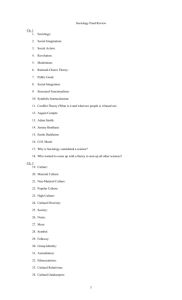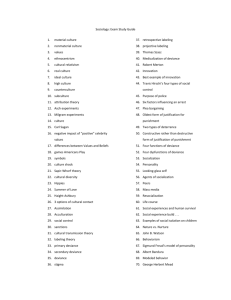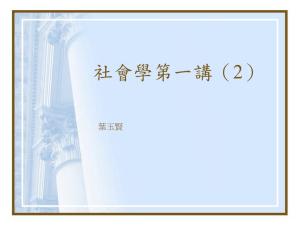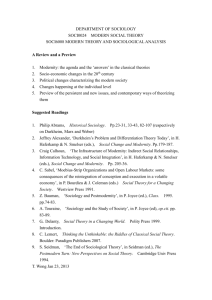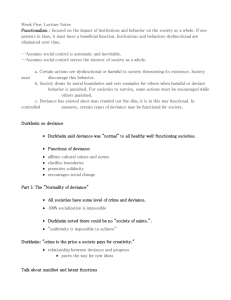What SI review will cover on Unit 2 learning guide
advertisement
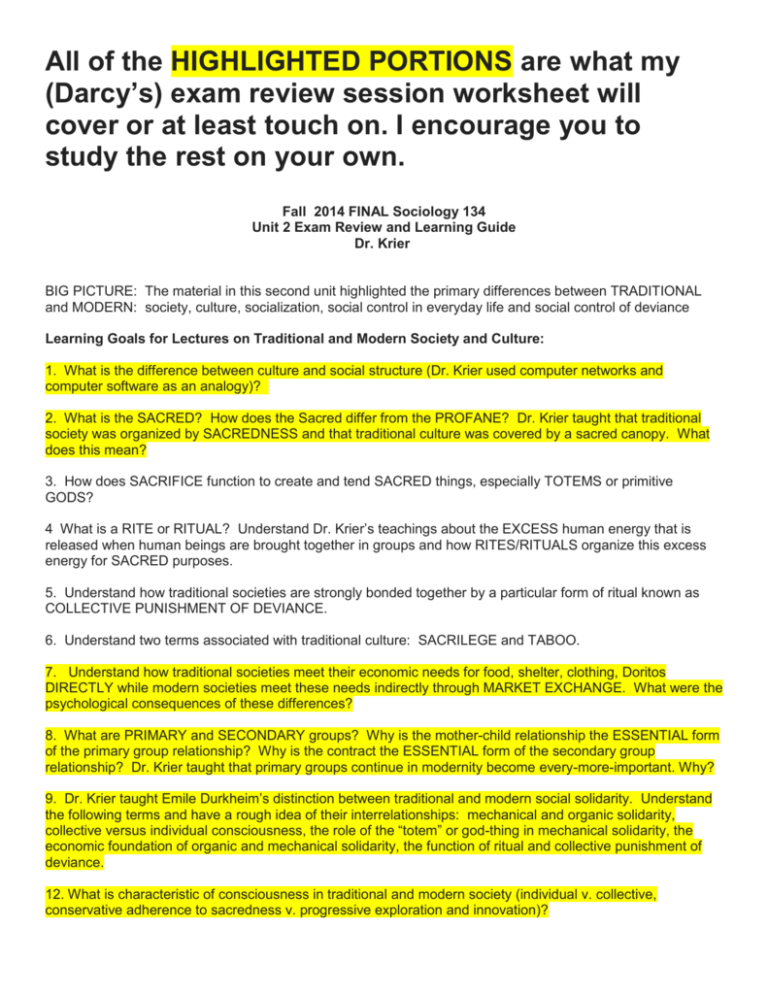
All of the HIGHLIGHTED PORTIONS are what my (Darcy’s) exam review session worksheet will cover or at least touch on. I encourage you to study the rest on your own. Fall 2014 FINAL Sociology 134 Unit 2 Exam Review and Learning Guide Dr. Krier BIG PICTURE: The material in this second unit highlighted the primary differences between TRADITIONAL and MODERN: society, culture, socialization, social control in everyday life and social control of deviance Learning Goals for Lectures on Traditional and Modern Society and Culture: 1. What is the difference between culture and social structure (Dr. Krier used computer networks and computer software as an analogy)? 2. What is the SACRED? How does the Sacred differ from the PROFANE? Dr. Krier taught that traditional society was organized by SACREDNESS and that traditional culture was covered by a sacred canopy. What does this mean? 3. How does SACRIFICE function to create and tend SACRED things, especially TOTEMS or primitive GODS? 4 What is a RITE or RITUAL? Understand Dr. Krier’s teachings about the EXCESS human energy that is released when human beings are brought together in groups and how RITES/RITUALS organize this excess energy for SACRED purposes. 5. Understand how traditional societies are strongly bonded together by a particular form of ritual known as COLLECTIVE PUNISHMENT OF DEVIANCE. 6. Understand two terms associated with traditional culture: SACRILEGE and TABOO. 7. Understand how traditional societies meet their economic needs for food, shelter, clothing, Doritos DIRECTLY while modern societies meet these needs indirectly through MARKET EXCHANGE. What were the psychological consequences of these differences? 8. What are PRIMARY and SECONDARY groups? Why is the mother-child relationship the ESSENTIAL form of the primary group relationship? Why is the contract the ESSENTIAL form of the secondary group relationship? Dr. Krier taught that primary groups continue in modernity become every-more-important. Why? 9. Dr. Krier taught Emile Durkheim’s distinction between traditional and modern social solidarity. Understand the following terms and have a rough idea of their interrelationships: mechanical and organic solidarity, collective versus individual consciousness, the role of the “totem” or god-thing in mechanical solidarity, the economic foundation of organic and mechanical solidarity, the function of ritual and collective punishment of deviance. 12. What is characteristic of consciousness in traditional and modern society (individual v. collective, conservative adherence to sacredness v. progressive exploration and innovation)? 13. What features of traditional and modern social structure were on view in the film, BARAKA, that we watched in class? 14. What is the view of society and culture from the ORDER and CONFLICT models? Learning Goals for Lectures on Socialization: 1. Understand the nature-nurture debate and the sophisticated resolution of this debate that is the foundation of 21st century work on socialization? (see slide series for discussion of this). 2. Understand traditional society’s notion of innate evil in humans (more or less strong depending upon the culture). Understand modernity’s development of a notion of innate goodness in humans. Understand the absolutely critical role this assumption plays in socialization practices. 3. We discussed research on physical punishment of children (Murray Strauss’s summary of late 20th century research). Understand in detail the summary of this research. Are the outcomes of physical punishment that Murray synthesizes consistent with democratic modernity (or with a “good modernity” in the eyes of Spencer, Weber, Durkheim)? Are they consistent with non-democratic modernity (or the bad modernity of Spencer, Weber and Durkheim)? 4. The Big Point: What role should social science play in shaping modern life? What are the barriers to social science based reform in our time? 5. What is the view of socialization from the ORDER and CONFLICT models (see text)? Learning Goals for Lectures on Social Control (Lecture on October 7, 2014): 1. Know the sociological definition of Social Control as mechanisms ensuring conformity and the suppression of deviance. 2. Understand the Order Versus Conflict View of Social Control 3. Understand the significance of internalization of societal norms and standards (Talcott Parsons and a guilty conscience/superego) that is especially important in the order view. 4. Understand the conflict view’s stress upon ideological control and manipulation as a mechanism to create false consensus around societal norms. 5. Understand differences between Traditional and Modern Social Control to include: traditional informal versus modern formal control, traditional society’s small size, permanence and stability that enables mechanical solidarity and collective consciousness as mechanisms of control, modern society’s large size, impermanence and instability that make traditional social control impossible; the spread of unprecedented situations and spaces in modernity, including cabarets, film theatres, factories, urban regions; the rise of modern privacy and loneliness. 6. William Isaac Thomas as a theorist of Modern Social Control. What is the definition of the situation and how does it structure/control modern 7. Erving Goffman as a theorist of Modern Social Control. Understand the role of “acting” and dramaturgy in modern life. Why is all the world a stage, at least in modernity? What question does the “definition of the situation” answer? How do definitions of situations shape conduct? What is idealization and dramatic realization? Understand the distinction between Backstage/Frontstage in everyday life. What are new types of MODERN MORALITY(Team discipline, team loyalty, derogation of the absent, audience tact)? 8. Emile Durkheim’s Suicide and Modern Social Control: Understand Durkheim’s explanation of suicide as a result of four social forces: altruism, fatalism, egoism and anomie. How does a person controlled by each force (altruists, fatalists, egoists, anomic self) experience the world? Why would each commit suicide? Learning Goals for Lectures on Deviance and Punishment (Lecture on October 9, 2014): 1. Define and differentiate informal DEVIANCE and formal CRIME? a. Understand the relationship between Emile Durkheim’s mechanical solidarity and collective punishment of deviance (especially TABOO/SACRILEGE). Understand features of traditional control of deviance: the centrality of punishment, a assumptions about human nature, role of punishment in social life, forms of punishment, significance of sacrilege. Understand contemporary moral crusades and clique-shaming behavior as punishment of traditional deviance by mechanically bonded groups. 2. Understand the particularly brutal Christian-on-Christian punishment during Protestant Reformation and its long-term consequences for European and American politics and society. a. Elongated torture (like drawing and quartering) reserved for sacrilege b. Above all else, be able to answer the question: why are deviants punished in traditional society with a nuanced answer. 3. Understand the relationship between Emile Durkheim’s organic solidarity and contractual control of deviance. Why does punishment become less important to modern societies? Why does the collective consciousness shrink? What happens when traditional deviance goes unpunished? What one thing becomes a “new crime” in modernity? Understand how modernity’s deviance is controlled with contracts and lawsuits for compensatory damages. Modern control of deviance through reform in penitentiaries. What is the purpose of reform? How does the Panopticon work to reform character? 4. SUMMARY POINTS: Emile Durkheim and the importance of sociological education in modern democracies. The key question: how does the “denial of dependency upon others” undermine organic solidarity? How does fearful adherence to a weakened SACRED order undermine organic solidarity? 5. What kind of bad modernity does Emile Durkheim fear most (resurgent mechanical solidarity in the midst of the modern world)? What would abnormal or destructive mechanical solidarity look like in modernity? These themes are related to Dr. Krier’s teaching on Carl Schmitt’s concept “political theology” and the resurgence of sacredness in our post-modern times.
